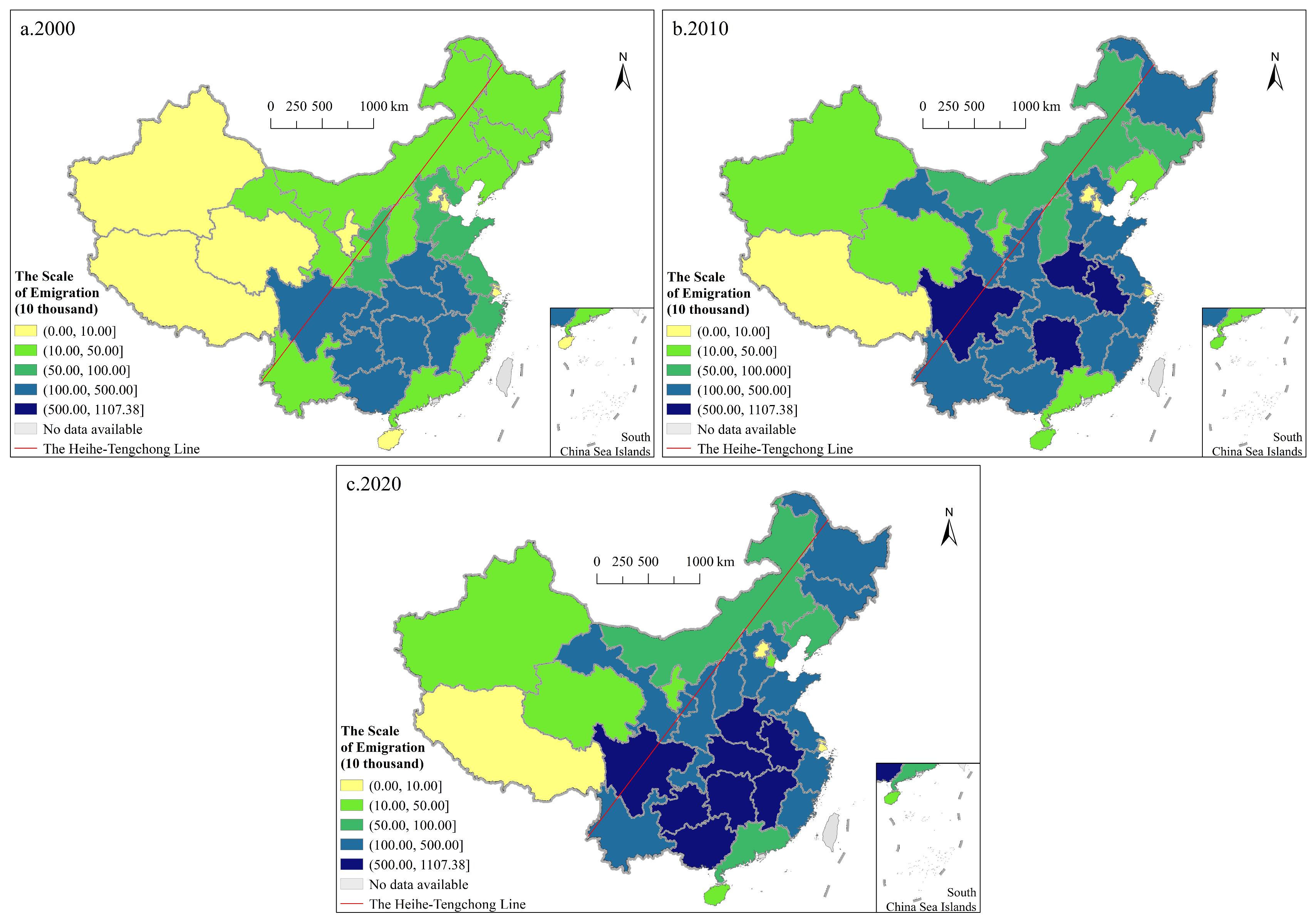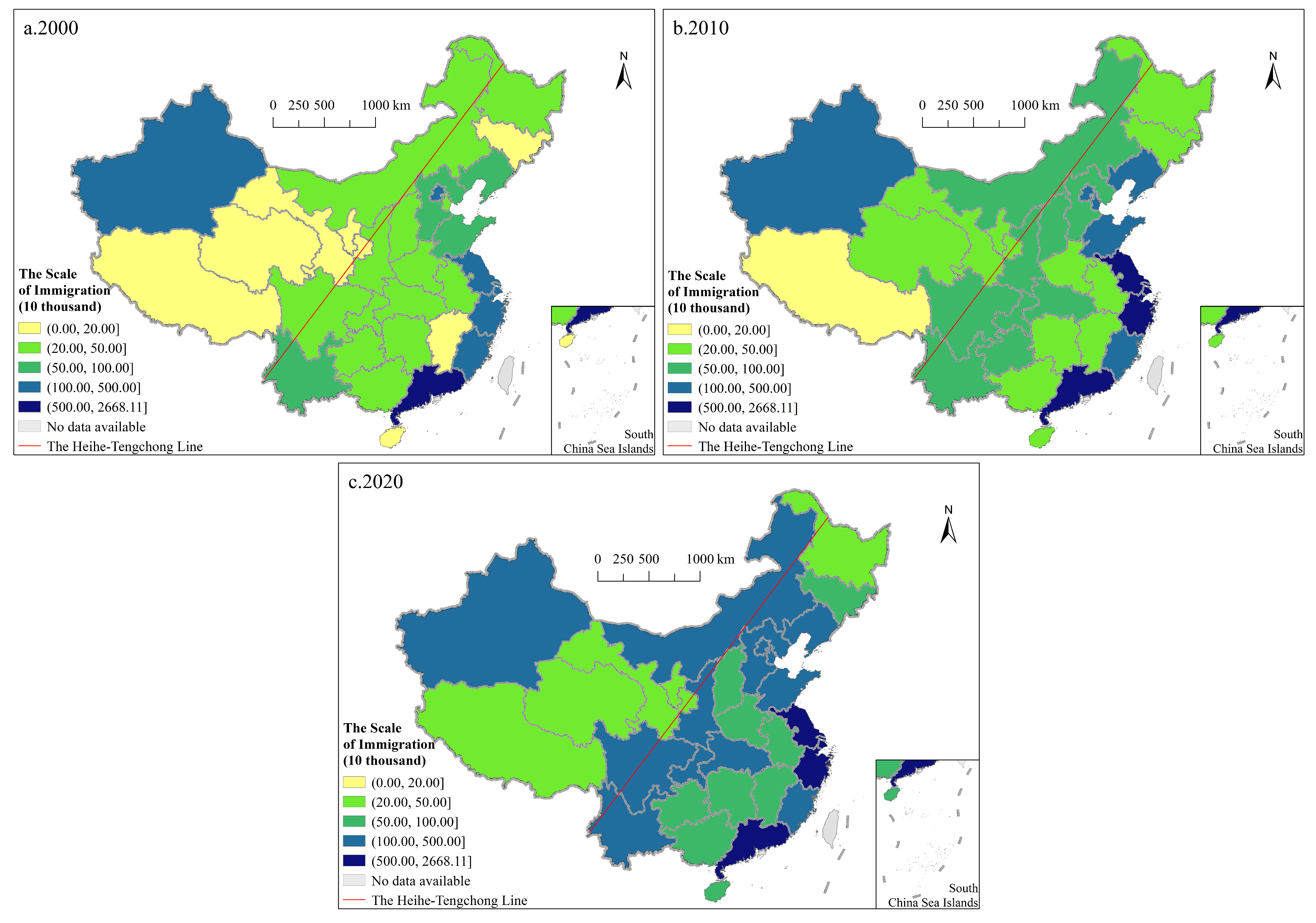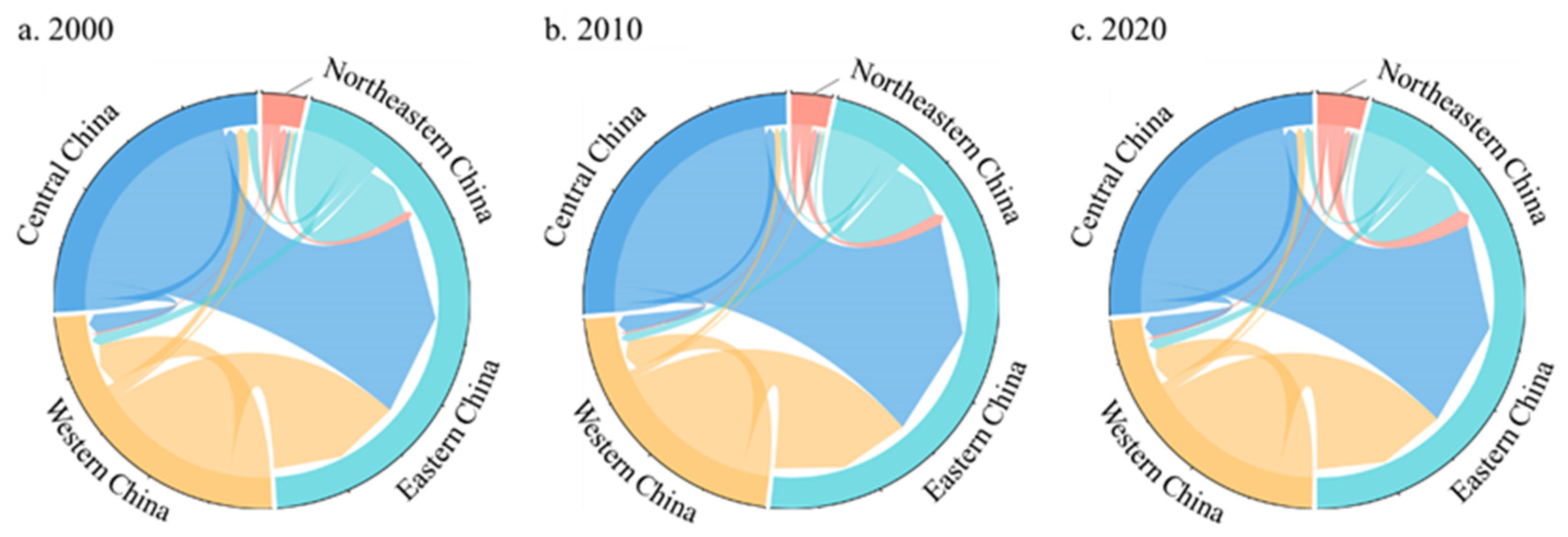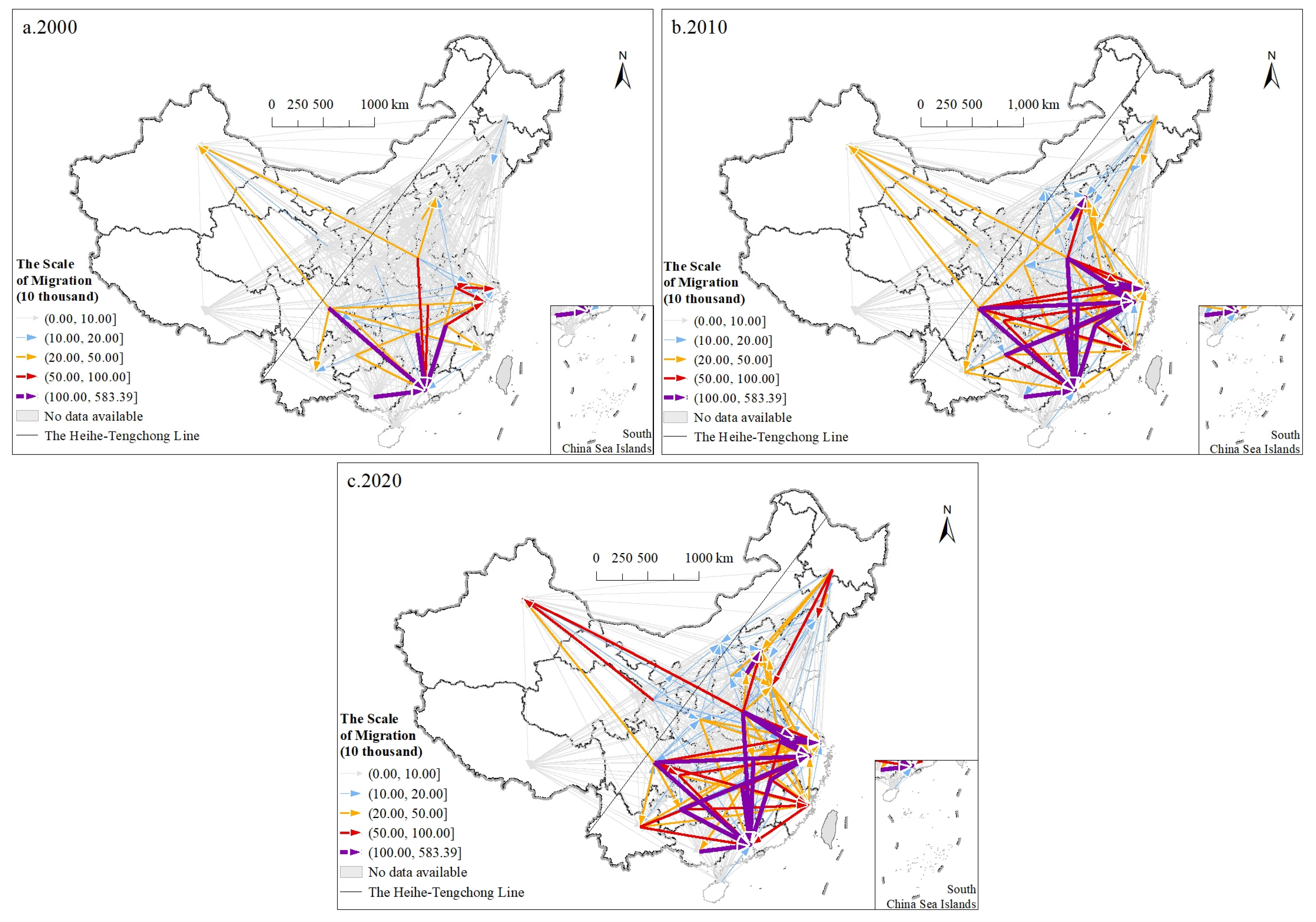Spatio-Temporal Pattern of Interprovincial Migration of Rural Population in China and Its Influencing Factors
Abstract
1. Introduction
2. Materials and Methods
2.1. Social Network Analysis
2.2. Model Construction
2.3. Data Sources and Processing
3. Results
3.1. Spatial Patterns of Interprovincial Rural Migration
3.2. Network Characteristics of Interprovincial Rural Migration
3.3. Influencing Factors of Interprovincial Rural Migration
4. Discussion
4.1. Gradually Reversed Rural Migration
4.2. National Strategy-Oriented Suggestions
4.3. Limitations and Future Prospects
5. Conclusions
Author Contributions
Funding
Institutional Review Board Statement
Informed Consent Statement
Data Availability Statement
Acknowledgments
Conflicts of Interest
References
- Khanna, P. Move: Where People Are Going for a Better Future; Scribner: Farmington, NY, USA, 2021. [Google Scholar]
- Collier, P. Exodus: How Migration Is Changing Our World; Oxford University Press: Cambridge, MA, USA, 2013. [Google Scholar]
- Rodrigue, J.-P. The Geography of Transport Systems; Routledge: London, UK, 2020. [Google Scholar]
- Malmberg, G. International Migration, Immobility and Development; Routledge: London, UK, 2021; pp. 21–48. [Google Scholar]
- Edelstein, M.; Koser, K.; Heymann, D.L. Humanitarian Crises and Migration; Routledge: London, UK, 2014; pp. 97–112. [Google Scholar]
- Chakraborty, I.; Maity, P. COVID-19 outbreak: Migration, effects on society, global environment and prevention. Sci. Total Environ. 2020, 728, 138882. [Google Scholar] [CrossRef] [PubMed]
- Zhang, Y.; Guo, X.; Su, Y.; Koura, H.Y.H.; Wang, N.; Song, W. Changes in spatiotemporal pattern and network characteristics in population migration of China’s cities before and after COVID-19. Hum. Soc. Sci. Commun. 2023, 10, 673. [Google Scholar] [CrossRef]
- Stark, O.; Bloom, D.E. The new economics of labor migration. Am. Econ. Rev. 1985, 75, 173–178. [Google Scholar]
- Ewers, M.C. Migrants, markets and multinationals: Competition among world cities for the highly skilled. GeoJournal 2007, 68, 119–130. [Google Scholar] [CrossRef]
- Martin, P.; Straubhaar, T. Best practices to reduce migration pressures. Int. Migr. 2002, 40, 5–23. [Google Scholar] [CrossRef]
- Castles, S. Twenty-first-century migration as a challenge to sociology. J. Ethn. Migr. Stud. 2007, 33, 351–371. [Google Scholar] [CrossRef]
- Li, J.; Dong, H.; Li, S. Economic development and optimal allocation of land use in ecological emigration area in China. Land Use Pol. 2024, 142, 107178. [Google Scholar] [CrossRef]
- Nguyen, C.H. Development and brain drain: A review of Vietnamese labour export and skilled migration. Migr. Dev. 2014, 3, 181–202. [Google Scholar] [CrossRef]
- Li, H. On the outflow of rural population and the changes of traditional farming culture in the Zhuang society—A case study of Futai, a Zhuang village. Guangxi Ethn. Stud. 2015, 93–100. [Google Scholar] [CrossRef]
- Liu, Y.; Li, Y. Revitalize the world’s countryside. Nature 2017, 548, 275–277. [Google Scholar] [CrossRef]
- Lee, E.S. A theory of migration. Demography 1966, 3, 47–57. [Google Scholar] [CrossRef]
- Ramos, R. Gravity models: A tool for migration analysis. IZA World of Labor 2016, 239, 1–10. [Google Scholar] [CrossRef]
- Todaro, M.P. A model of labor migration and urban unemployment in less developed countries. Am. Econ. Rev. 1969, 59, 138–148. [Google Scholar]
- Chan, K.W.; Zhang, L. The hukou system and rural-urban migration in China: Processes and changes. China Q. 1999, 160, 818–855. [Google Scholar] [CrossRef]
- Chan, K.W. Urbanization with Chinese Characteristics: The Hukou System and Migration; Routledge: London, UK, 2018; pp. 166–189. [Google Scholar]
- Cheng, T.; Selden, M. The origins and social consequences of China’s hukou system. China Q. 1994, 139, 644–668. [Google Scholar] [CrossRef]
- Song, Y. What should economists know about the current Chinese hukou system? China Econ. Rev. 2014, 29, 200–212. [Google Scholar] [CrossRef]
- Chan, K.W. The Chinese hukou system at 50. Eurasian Geogr. Econ. 2009, 50, 197–221. [Google Scholar] [CrossRef]
- Young, J. China’s Hukou System: Markets, Migrants and Institutional Change; Palgrave Macmillan: London, UK, 2013. [Google Scholar]
- So, A.Y. China’s Developmental Miracle: Origins, Transformations, and Challenges; Routledge: London, UK, 2016. [Google Scholar]
- Duan, C.; Lyu, L.; Wang, H.; Xie, D. From rural China to migrating China: Rethinking migration transition in China. Popul. Res. 2020, 44, 19. [Google Scholar]
- Deng, Y.; Liu, S.; Cai, J.; Lu, X.; Nielsen, C.P. Spatial pattern and its evolution of Chinese provincial population: Methods and empirical study. J. Geogr. Sci. 2015, 25, 1507–1520. [Google Scholar] [CrossRef]
- Liu, Z.; Gu, H. Evolution characteristics of spatial concentration patterns of interprovincial population migration in China from 1985 to 2015. Appl. Spat. Anal. Policy 2020, 13, 375–391. [Google Scholar] [CrossRef]
- Qi, W.; Abel, G.J.; Liu, S. Geographic transformation of China’s internal population migration from 1995 to 2015: Insights from the migration centerline. Appl. Geogr. 2021, 135, 102564. [Google Scholar] [CrossRef]
- Wu, J.; Yu, Z.; Wei, Y.D.; Yang, L. Changing distribution of migrant population and its influencing factors in urban China: Economic transition, public policy, and amenities. Habitat. Int. 2019, 94, 102063. [Google Scholar] [CrossRef]
- Qin, B.; Peng, Y.; Wan, S. The geography of older adults’ migration in China: Spatial patterns and driving forces. Popul. Space Place 2024, 30, e2754. [Google Scholar] [CrossRef]
- Liang, Z.; Chen, Y.P. The educational consequences of migration for children in China. Soc. Sci. Res. 2007, 36, 28–47. [Google Scholar] [CrossRef]
- Mou, J.; Griffiths, S.M.; Fong, H.F.; Dawes, M.G. Defining migration and its health impact in China. Public. Health 2015, 129, 1326–1334. [Google Scholar] [CrossRef] [PubMed]
- Qi, W.; Zuo, J.; Li, G.; Yao, L. Residential carbon emission flows embedded in population migration over time in China: A geospatial dynamics analysis. Resour. Conserv. Recycl. 2025, 212, 107919. [Google Scholar] [CrossRef]
- Hao, T.; Sun, R.; Tombe, T.; Zhu, X. The effect of migration policy on growth, structural change, and regional inequality in China. J. Monet. Econ. 2020, 113, 112–134. [Google Scholar] [CrossRef]
- Dou, X.; Liu, Y. Elderly migration in China: Types, patterns, and determinants. J. Appl. Gerontol. 2017, 36, 751–771. [Google Scholar] [CrossRef]
- Huang, H. Review of theoretical and empirical studies of elderly migration. Hum. Geogr. 2013, 28, 27–33. [Google Scholar]
- Wan, S.; Qin, B. A review of elderly migration research and implications. Progr. Geogr. 2022, 41, 922–934. [Google Scholar] [CrossRef]
- Bai, C.; Lei, X. New trends in population aging and challenges for China’s sustainable development. China Econ. J. 2020, 13, 3–23. [Google Scholar] [CrossRef]
- Howell, J. Prospects for village self-governance in China. J. Peasant. Stud. 1998, 25, 86–111. [Google Scholar] [CrossRef]
- Eggleston, K.; Sun, A.; Zhan, Z. The impact of rural pensions in China on labor migration. World Bank Econ. Rev. 2018, 32, 64–84. [Google Scholar]
- Wang, Y.; Chen, C.; Araral, E. The effects of migration on collective action in the commons: Evidence from rural China. World Dev. 2016, 88, 79–93. [Google Scholar] [CrossRef]
- Sun, X.; Chen, J.; Xie, S. Becoming urban citizens: A three-phase perspective on the social integration of rural–urban migrants in China. Int. J. Environ. Res. Public Health 2022, 19, 5946. [Google Scholar] [CrossRef] [PubMed]
- Zhao, Q.; Song, M.; Wang, H. Voting with your feet: The impact of urban public health service accessibility on the permanent migration intentions of rural migrants in China. Int. J. Environ. Res. Public Health 2022, 19, 14624. [Google Scholar] [CrossRef]
- Qi, M.; Wang, Y.; Miao, P.; Xu, Y.E. Research on the social stratification of rural-to-urban migrants in China and paths to the granting of urban residency. China Popul. Dev. Stud. 2022, 6, 403–424. [Google Scholar] [CrossRef]
- Zhao, L.; Liu, S.; Zhang, W. New trends in internal migration in China: Profiles of the New-generation migrants. China World Econ. 2018, 26, 18–41. [Google Scholar] [CrossRef]
- Zhang, J.; Yan, L.; Yuan, Y. Rural-urban migration and mental health of Chinese migrant children: Systematic review and meta-analysis. J. Affect. Disord. 2019, 257, 684–690. [Google Scholar] [CrossRef]
- Li, Z.; Liu, D.; Lin, S. A literature review of the study on return floating population in China. Hum. Geogr. 2020, 35, 1–10. [Google Scholar]
- Xiong, T.; Liu, W. Hot topics and frontier evolution of studies on domestic migrant workers. J. Libr. Inf. Sci. Agric. 2021, 33, 45–62. [Google Scholar]
- Scott, J. What is Social Network Analysis; Bloomsbury Academic: London, UK, 2012. [Google Scholar]
- Akbari, H. Exploratory social-spatial network analysis of global migration structure. Soc. Netw. 2021, 64, 181–193. [Google Scholar] [CrossRef]
- Plotnikova, M.; Ulceluse, M. Inequality as a driver of migration: A social network analysis. Popul. Space Place 2022, 28, e2497. [Google Scholar] [CrossRef]
- Wu, F.; Guclu, H. Global maize trade and food security: Implications from a social network model. Risk Anal. 2013, 33, 2168–2178. [Google Scholar] [CrossRef]
- Wang, J.; Dai, C. Evolution of global food trade patterns and its implications for food security based on complex network analysis. Foods 2021, 10, 2657. [Google Scholar] [CrossRef]
- Zhong, C.; Arisona, S.M.; Huang, X.; Batty, M.; Schmitt, G. Detecting the dynamics of urban structure through spatial network analysis. Int. J. Geogr. Inf. Sci. 2014, 28, 2178–2199. [Google Scholar] [CrossRef]
- Freeman, L.C. Centrality in social networks: Conceptual clarification. Soc. Netw. 2002, 1, 238–263. [Google Scholar] [CrossRef]
- Li, Y.; Lu, Y. Complex Projects Organization Networking: Perspectives from Centrality, Centralization and Power. In Proceedings of the 2010 International Conference on Management and Service Science, Wuhan, China, 24–26 August 2010. [Google Scholar]
- Borgatti, S.; Everett, M.; Freeman, L.C. Ucinet for Windows: Software for Social Network Analysis; Analytic Technologies: Harvard, MA, USA, 2002. [Google Scholar]
- Ravenstein, E.G. The laws of migration. J. R. Stat. Soc. 1889, 52, 241–305. [Google Scholar] [CrossRef]
- Henry, S.; Boyle, P.; Lambin, E.F. Modelling inter-provincial migration in Burkina Faso, West Africa: The role of socio-demographic and environmental factors. Appl. Geogr. 2003, 23, 115–136. [Google Scholar] [CrossRef]
- Castelli, F. Drivers of migration: Why do people move? J. Travel. Med. 2018, 25, tay040. [Google Scholar] [CrossRef]
- Guo, Y.; Zhou, Y.; Liu, Y. Spatial-temporal evolution of rural population outflow and its mechanism in China. Sci. Geol. Sin. 2020, 40, 50–59. [Google Scholar]
- Urbański, M. Comparing push and pull factors affecting migration. Economies 2022, 10, 21. [Google Scholar] [CrossRef]
- De Haas, H. A theory of migration: The aspirations-capabilities framework. Comp. Migr. Stud. 2021, 9, 8. [Google Scholar] [CrossRef] [PubMed]
- You, Z.; Feng, Z.; Yang, Y. Relief degree of land surface dataset of China (1 km). J. Glob. Chang. Data Discov. 2018, 2, 151–155. [Google Scholar]
- Yang, D. Patterns of China’s regional development strategy. China Q. 1990, 122, 230–257. [Google Scholar] [CrossRef]
- Fan, C.C. Uneven development and beyond: Regional development theory in post-Mao China. Int. J. Urban. Reg. Res. 1997, 21, 620–639. [Google Scholar] [CrossRef]
- Lin, J.Y.; Cai, F.; Li, Z. The China miracle: Development Strategy and Economic Reform, Revised Edition; The Chinese University of Hong Kong Press: Hongkong, China, 2004. [Google Scholar]
- Zhao, Y. Leaving the countryside: Rural-to-urban migration decisions in China. Am. Econ. Rev. 1999, 89, 281–286. [Google Scholar] [CrossRef]
- Qi, Z. An overview of rural to urban migration in China and social challenges. Migr. Lett. 2019, 16, 273–282. [Google Scholar] [CrossRef]
- Zhao, P.; Yuan, D. Population Growth and Sustainable Transport in China; Springer: Berlin/Heidelberg, Germany, 2023. [Google Scholar]
- Qin, C. Study on the system of mechanisms for regional coordination and development. Economist 2011, 4, 63–70. [Google Scholar]
- Sun, B.; Zheng, Y. Review, evaluation and inspiration of regional development strategies in China. Hum. Geogr. 2014, 29, 1–7. [Google Scholar]
- Wang, X.; Zheng, G. Narrating regional coordinated development: Discursive practices in China’s city-regions. Cities. 2024, 146, 104768. [Google Scholar] [CrossRef]
- Tian, Y.; Jiang, G.; Zhou, D.; Ding, K.; Su, S.; Zhou, T.; Chen, D. Regional industrial transfer in the Jingjinji urban agglomeration, China: An analysis based on a new “transferring area-undertaking area-dynamic process” model. J. Clean. Prod. 2019, 235, 751–766. [Google Scholar] [CrossRef]
- Xu, G.; Geng, M.; Schwarz, P.; Dong, H.; Gong, Y.; Yang, H.; Thomas, M. The effect of industrial relocations to central and Western China on urban construction land expansion. J. Land. Use Sci. 2021, 16, 339–357. [Google Scholar] [CrossRef]
- Li, H.; Li, L.; Wu, B.; Xiong, Y. The end of cheap Chinese labor. J. Econ. Perspect. 2012, 26, 57–74. [Google Scholar] [CrossRef]
- Butollo, F. The End of Cheap Labour?: Industrial Transformation and Social Upgrading in China; Campus: Frankfurt, Germany, 2014. [Google Scholar]
- Wang, X.; Chan, C.K.-C.; Yang, L. Economic upgrading, social upgrading, and rural migrant workers in the Pearl River Delta. China Rev. 2020, 20, 51–82. [Google Scholar]
- Liu, Y.; Zhang, X. Does labor mobility follow the inter-regional transfer of labor-intensive manufacturing? The spatial choices of China’s migrant workers. Habitat. Int. 2022, 124, 102559. [Google Scholar] [CrossRef]
- Wang, X.; Chan, C.K.-C.; Yang, L. Economic restructuring and migrant workers’ coping strategies in China’s Pearl River Delta. Third World Q. 2021, 42, 812–830. [Google Scholar] [CrossRef]
- Chan, K.W. Recent migration in China: Patterns, trends, and policies. Asian Perspec. 2001, 25, 127–155. [Google Scholar] [CrossRef]
- Gu, C. Urbanization: Processes and driving forces. Sci. China Earth Sci. 2019, 62, 1351–1360. [Google Scholar] [CrossRef]
- Liu, Y.; Zang, Y.; Yang, Y. China’s rural revitalization and development: Theory, technology and management. J. Geogr. Sci. 2020, 30, 1923–1942. [Google Scholar] [CrossRef]
- Liu, Y. Urban-Rural Transformation Geography; Springer: Berlin/Heidelberg, Germany, 2021. [Google Scholar]
- Guo, Y.; Wang, J. Practices for rural population aging in China: Land-based pension. Habitat. Int. 2024, 151, 103136. [Google Scholar] [CrossRef]
- Li, H.; Chen, K.; Yan, L.; Yu, L.; Zhu, Y. Citizenization of rural migrants in China’s new urbanization: The roles of hukou system reform and rural land marketization. Cities 2023, 132, 103968. [Google Scholar] [CrossRef]
- De Haas, H. The migration and development pendulum: A critical view on research and policy. Int. Migr. 2012, 50, 8–25. [Google Scholar] [CrossRef]
- Chen, M.; Zhou, Y.; Huang, X.; Ye, C. The integration of new-type urbanization and rural revitalization strategies in China: Origin, reality and future trends. Land 2021, 10, 207. [Google Scholar] [CrossRef]
- Phillips, N. Migration as development strategy? The new political economy of dispossession and inequality in the Americas. Rev. Int. Polit. Econ. 2009, 16, 231–259. [Google Scholar] [CrossRef]
- Cassen, R. Population and Development: Old Debates, New Conclusions; Routledge: London, UK, 1994. [Google Scholar]
- Liu, Y.; Li, X.; Guo, Y. Exploring land system reform for demographic transition in rural China. Land. Use Pol. 2024, 147, 107355. [Google Scholar] [CrossRef]
- Castles, S. The factors that make and unmake migration policies. Int. Migr. Rev. 2004, 38, 852–884. [Google Scholar] [CrossRef]
- Feng, W.; Zuo, X.; Ruan, D. Rural migrants in shanghai: Living under the shadow of socialism. Int. Migr. Rev. 2002, 36, 520–545. [Google Scholar] [CrossRef]
- Murphy, R. Labour Migration and Social Development in Contemporary China; Routledge: London, UK, 2009. [Google Scholar]





| Indicator | Definition | Formula | |
|---|---|---|---|
| Network density | Network density characterizes the closeness of links between nodes in a population migration network. | (1) | |
| Outdegree centralization | Degree centralization measures the tendency of a single node to be more central than all other nodes in the network. Outdegree centralization quantifies the extent to which a network’s nodes are dominated by a single node or a small group of nodes in terms of outgoing connections. Similarly, indegree centralization measures the extent to which a network’s nodes are dominated by a single node or a small group of nodes in terms of incoming connections. The higher the outdegree centralization, the lower is the variability in node outdegree centralities; the higher the indegree centralization, the lower is the variability in node indegree centralities. | (2) | |
| (3) | |||
| Indegree centralization | (4) | ||
| (5) | |||
| Betweenness centralization | Betweenness centralization denotes the difference between the node with the highest betweenness centrality and the average in a network. The higher this differential, the more important the intermediary becomes, especially as the network evolves into several smaller sub-networks. | (6) | |
| (7) | |||
| Dimension | Variable | Definition | Abbreviation |
|---|---|---|---|
| Regional environment | Rural hukou population | Population according to the household registration system (Person) | S_rpopu/D_rpopu |
| Individual characteristics | Educational attainment of rural population | Years of schooling per capita according to resident population (Year) | S_eduatt/D_eduatt |
| Regional environment | Per capita GDP | GDP divided by mid-year population (CNY) | S_pgdp/D_pgdp |
| Regional environment | Number of beds in health facilities per 1000 people | Number of beds of health care institutions at year-end/population at year-end × 1000 (beds) | S_health/D_health |
| Regional environment | Internet penetration rate | Number of internet users as a percentage of total resident population (%) | S_internet/D_internet |
| Regional environment | Natural disasters | Total population affected by natural disasters (10,000 person-times) | S_disaster/D_disaster |
| Spatial barriers | Topographic relief | Standard deviation of regional DEM rasters (-) | S_topo/D_topo |
| Spatial barriers | Spatial distance | Distance between centers of gravity based on administrative maps (km) | distance |
| Indicator | 2000 | 2010 | 2020 |
|---|---|---|---|
| Number of relationships | 361 | 133 | 43 |
| Network density | 0.388 | 0.143 | 0.046 |
| Outdegree centralization (%) | 39.11 | 43.78 | 33.11 |
| Indegree centralization (%) | 56.33 | 36.89 | 22.78 |
| Betweenness centralization (%) | 10.54 | 4.01 | 0.96 |
| OLS | RE | FE | FE_TW | LSDV | ||||||
|---|---|---|---|---|---|---|---|---|---|---|
| Coefficient | z | Coefficient | z | Coefficient | z | Coefficient | z | Coefficient | z | |
| ln S_rpopu | 0.44 *** | −7.16 | 0.58 *** | 12.45 | −0.06 | −0.57 | −0.15 | −1.18 | −0.15 | −0.97 |
| ln S_eduatt | −1.81 *** | −5.83 | −1.84 *** | −5.83 | −1.07 ** | −2.25 | −0.50 | −0.81 | −0.50 | −0.66 |
| ln S_pgdp | −0.40 *** | −6.47 | −0.19 *** | −3.79 | 0.01 | 0.23 | −0.21 *** | −2.92 | −0.21 ** | −2.38 |
| ln S_health | 0.59 *** | 9.47 | 0.41 *** | 9.49 | 0.04 | −0.66 | 0.04 | 0.55 | 0.04 | 0.45 |
| ln S_internet | −0.00 | −0.15 | −0.01 *** | −3.24 | −0.01 *** | −4.43 | −0.01 *** | −5.03 | −0.01 *** | −4.10 |
| ln S_disaster | 0.15 *** | 6.56 | 0.14 *** | 11.03 | 0.11 *** | 7.16 | 0.11 *** | 7.72 | 0.11 *** | 6.30 |
| ln S_topo | 0.01 | 1.18 | 0.01 | 1.34 | 0.00 | - | 0.00 | - | 0.75 ** | 2.44 |
| ln D_rpopu | 1.13 *** | 18.59 | 0.70 *** | 15.05 | 0.75 *** | 7.02 | 0.66 *** | 5.05 | 0.66 *** | 4.11 |
| ln D_eduatt | 2.72 *** | 8.78 | 1.61 *** | 5.1 | −0.51 | −1.08 | 0.05 | 0.10 | 0.05 | 0.08 |
| ln D_pgdp | 1.18 *** | 19.02 | 0.84 *** | 16.86 | 0.64 *** | 11.51 | 0.41 *** | 5.18 | 0.41 *** | 4.22 |
| ln D_health | −0.44 *** | −6.99 | −0.14 *** | −3.14 | 0.16 *** | 2.8 | 0.16 * | 1.89 | 0.16 | 1.54 |
| ln D_internet | −0.00 | −1.40 | 0.00 * | 1.68 | 0.00 | 0.77 | −0.00 | −0.11 | −0.00 | −0.09 |
| ln D_disaster | −0.26 *** | −10.98 | −0.14 *** | −10.96 | −0.10 *** | −6.30 | −0.09 *** | −6.92 | −0.09 *** | −5.64 |
| ln D_topo | 0.01 ** | 2.08 | −0.02 * | −1.76 | 0.00 | - | 0.00 | - | −0.31 *** | −4.07 |
| ln distance | −1.20 *** | −35.00 | −1.20 *** | −22.49 | −0.08 | −0.24 | −0.07 ** | −2.34 | −0.07 * | −1.91 |
| Cons | −26.74 *** | −33.13 | −23.76 *** | −25.55 | −15.16 *** | −4.75 | −8.55 ** | −2.13 | −9.40 ** | −2.07 |
| N | 2790 | 2790 | 2790 | 2790 | 2790 | |||||
Disclaimer/Publisher’s Note: The statements, opinions and data contained in all publications are solely those of the individual author(s) and contributor(s) and not of MDPI and/or the editor(s). MDPI and/or the editor(s) disclaim responsibility for any injury to people or property resulting from any ideas, methods, instructions or products referred to in the content. |
© 2025 by the authors. Licensee MDPI, Basel, Switzerland. This article is an open access article distributed under the terms and conditions of the Creative Commons Attribution (CC BY) license (https://creativecommons.org/licenses/by/4.0/).
Share and Cite
Zhong, W.; Guo, Y. Spatio-Temporal Pattern of Interprovincial Migration of Rural Population in China and Its Influencing Factors. Appl. Sci. 2025, 15, 3029. https://doi.org/10.3390/app15063029
Zhong W, Guo Y. Spatio-Temporal Pattern of Interprovincial Migration of Rural Population in China and Its Influencing Factors. Applied Sciences. 2025; 15(6):3029. https://doi.org/10.3390/app15063029
Chicago/Turabian StyleZhong, Wenyue, and Yuanzhi Guo. 2025. "Spatio-Temporal Pattern of Interprovincial Migration of Rural Population in China and Its Influencing Factors" Applied Sciences 15, no. 6: 3029. https://doi.org/10.3390/app15063029
APA StyleZhong, W., & Guo, Y. (2025). Spatio-Temporal Pattern of Interprovincial Migration of Rural Population in China and Its Influencing Factors. Applied Sciences, 15(6), 3029. https://doi.org/10.3390/app15063029






